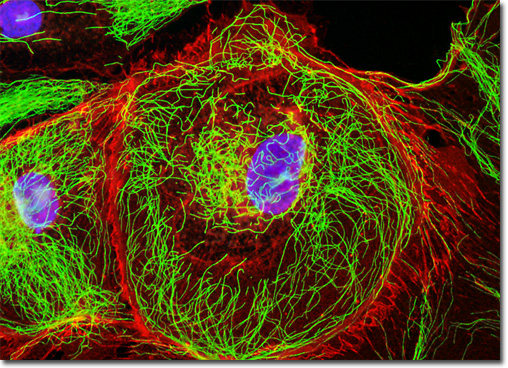Fluorescence Digital Image Gallery
Male Rat Kangaroo Kidney Epithelial Cells (PtK2)
|
Fluorochromes were introduced to fluorescence microscopy in the early twentieth century as vital stains for bacteria, protozoa, and trypanosomes, but did not see widespread use until the 1920s when fluorescence microscopy was first used to study dye binding in fixed tissues and living cells. However, it wasn't until the early 1940s that Albert Coons developed a technique for labeling antibodies with fluorescent dyes, thus giving birth to the field of immunofluorescence. Over the past 60 years, advances in immunology and molecular biology have produced a wide spectrum of secondary antibodies and provided insight into the molecular design of fluorescent probes targeted at specific regions within macromolecular complexes. The culture of rat kangaroo kidney cells appearing in the digital image above was immunofluorescently labeled with primary anti-beta-catenin rabbit monoclonal antibodies followed by goat anti-rabbit secondary antibody fragments (Fab) conjugated to Rhodamine Red-X. Members of the catenin family of peripheral cytosolic proteins bind selectively to the highly conserved cytoplasmic tail domain of the cell-to-cell adhesion cadherin proteins. In addition, the specimen was subsequently counterstained for the cytoskeletal filamentous actin network with Alexa Fluor 488 conjugated to phalloidin, and for DNA in the cell nucleus with Hoechst 33258. Images were recorded in grayscale with a QImaging Retiga Fast-EXi camera system coupled to an Olympus BX-51 microscope equipped with bandpass emission fluorescence filter optical blocks provided by Omega Optical. During the processing stage, individual image channels were pseudocolored with RGB values corresponding to each of the fluorophore emission spectral profiles. |
© 1995-2025 by Michael W. Davidson and The Florida State University. All Rights Reserved. No images, graphics, software, scripts, or applets may be reproduced or used in any manner without permission from the copyright holders. Use of this website means you agree to all of the Legal Terms and Conditions set forth by the owners.
This website is maintained by our
|
